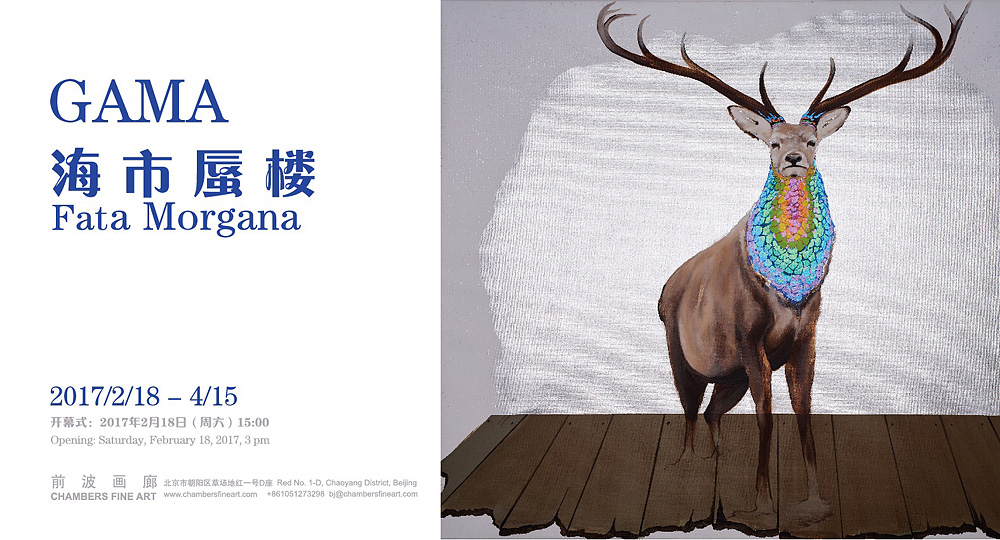前波画廊「海市蜃楼:GAMA新作」

海市蜃楼:GAMA新作
 Deer of Nine Colors 8 九色鹿 8
Deer of Nine Colors 8 九色鹿 8
2016,综合材料, 100 × 120 cm
北京前波画廊诚挚地宣布将于2017年2月18日起举办展览《海市蜃楼:GAMA新作》。这将是GAMA在前波画廊的第二次个展。
GAMA于1977年出生在内蒙古,1996年至2000年在中央美术学院学习,之后移居德国,2002至2007年在卡尔斯鲁厄艺术学院学习油画,并于2007年成为了艺术家古斯塔夫·克鲁格门下的研究生。目前GAMA在柏林工作和生活。
从中国移居到德国对GAMA来说影响深远,因为在德国他可以亲眼看到欧洲古典大师的真迹以及当代艺术家的作品,而这些之前在中国他都是只在印刷品中见到过。在此之前,GAMA并未能找到一种视觉语言来表达他与生俱来的丰富想象力。然而在德国,从中世纪的日耳曼艺术到十九世纪的浪漫主义艺术的作品、以及莱比锡画派的年轻艺术家笔下生动写实的人物形象,从各种方面帮助GAMA形成了其独特的视觉表现手法,不仅反映了他童年的记忆,也表现了他现存脑海中的幻想。
GAMA儿时在内蒙古大草原上以游牧形式生活,而他的姑婆是当地一位德高望重的萨满。尽管萨满教在苏联时期受到了镇压,但并未被灭绝。GAMA曾多次亲眼见到姑婆与灵界沟通,以找出是由什么邪魔入了肉身而导致了疾病,有时候当她进入昏睡状态时,口中会发出动物的叫喊声。
在《海市蜃楼》展览中,GAMA进一步发展了在上次个展《诸王的花谷》中所表现的混合风格,同时也以“九色鹿”系列把鹿变成了一个新的主角形象。从爱德温·亨利·兰塞尔爵士的“幽谷之王”(1851)到弗兰茨·马尔克的“林中小鹿”(1914),艺术家们都通过鹿来表达了不同的象征意义,但都遵从于动物本身的形态与举止。不同的是,给予GAMA的创作灵感源自于他姑婆在从人界通向灵界的入口处遇见的鹿。姑婆告诉他这些鹿守护着灵界,她只有给了它们暗号后才能通过。每一头鹿的巨大鹿角上有宝石般不同颜色的花纹,身上还会长有一些蘑菇,这些都暗示了这些鹿身上不同的“气”。
进入了这些由鹿守护的入口之后,萨满说她能看到只有她被允许看到的海市蜃楼。选择以“海市蜃楼”作为此次展览的标题,GAMA强调了他在作品中将文化与视觉援引独特的融合。海市蜃楼是由于冷暖空气的不同折射所发生的短暂幻景,在意大利语里“海市蜃楼”是以亚瑟王传说中的一个女巫名字命名。GAMA作品中充满令人诧异的视觉矛盾,例如此次展览中的作品“山谷Ⅲ”中持械的士兵与多彩手套的偶遇,以及“门Ⅲ”的空间跳跃,都与海市蜃楼的景象有着种种相似之处。
GAMA从来不通过幻觉主义来使观众分不清绘画与真实世界,相反他总是强调作品本身的质感,将颜料堆积在不规则形状的画面边缘,就好像会从画布上掉下来一样。画面中广阔的天空常常被一盏简单的灯所打破,而很多小矮人则隐匿于虚无之中。在近期的作品中,他进一步深入了这些想法,以发掘儿时在内蒙古的记忆与现居住地如此丰富的幻想世界之间的相似之处。
Chambers Fine Art is pleased to announce the opening on February 18, 2017 of Fata Morgana: New Works by GAMA. This will be his second exhibition at the gallery. Born in Inner Mongolia in 1977, GAMA studied at the Central Academy of Fine Arts (CAFA) in Beijing from 1996 to 2000 before moving to Karlsruhe, Germany in 2002 where he studied painting at the Staatlichen Akademie der Bildenden Künste from 2002 to 2007 and was master student under Gustav Kluge from 2007 to 2008. He currently lives and works in Berlin.
The move from China to Germany was a transformative experience for GAMA as he was able to see first- hand works by European Old Masters and contemporary artists that he had previously seen only in reproductions. Gifted with a vivid imagination to which he had not yet been able to give visual expression, GAMA found that exposure to the work of many aspects of Germanic art from the Middle Ages to the nineteenth century Romanticism and the vigorous figurative characteristic of young artists associated with the Leipzig School enabled him to formulate an eccentric visual language that embraced both childhood memories and more recent fantasies.
GAMA’s formative years were spent in Inner Mongolia where his family lived a traditional nomadic existence and his aunt was an important shaman. Although suppressed during the period of Soviet domination, shamanism never really died out and GAMA was present on many occasions when his aunt entered into communion with the spirit world, one of the primary reasons being to identify the spirits responsible for physical ailments. On other occasions when she entered a trance, animal sounds would emerge from her mouth.
In Fata Morgana GAMA develops the hybrid style that characterized Idylls of the Kings while giving new prominence to representations of deer in the sequence of paintings titled Deer of Nine Color. From Sir Edwin Landseer’s Monarch of the Glen (1851) to Franz Marc’s Deer in the Forest (1914), artists have deer for a variety of symbolic purposes although always based on the appearance and behavior of actual animals. GAMA’s deer, in contrast, are inspired by the deer that his aunt encountered guarding the doors that separate the actual world from the spirit world. She informed him that these deer act as guardians of the world beyond and that she could only gain admittance through the exchange of a secret code. Endowed with massive antlers, each deer has a different qi indicated by multiple signs including jewel-like colored patches and mushrooms growing out of the animal’s fur.
Once permitted entry through the doors guarded by the deer, the shaman speaks of seeing mirages that only she is permitted to see. In choosing Fata Morgana as title of the exhibition GAMA underscores the highly individual melding of cultural and visual references that characterize his visual language. Fata morgana are fleeting mirages caused by the relationship between layers of cool and warm air, named after a powerful sorceress in the Arthurian legends. GAMA’s unsettling paintings with their multiple visual inconsistencies such the encounter between armed soldiers and a multi-colored glove in Tal (Valley) III or the visual inconsistencies of Das Tor (The Door) III have many characteristics in common with these fleeting visions.
In his paintings GAMA has always downplayed illusionism by drawing attention to their physical qualities, allowing oil paint to accumulate around the edges of irregularly shaped areas that look as if they could be peeled off the surface of the canvas. A naively painted light fixture frequently interrupts an expanse of sky and many of his homunculi dissolve into nothingness. His new paintings develop these ideas as he seeks analogies between childhood memories of Inner Mongolia and the world of fantasy so richly explored in the country where he has chosen to live.
[本文所有内容均来自:前波画廊]
